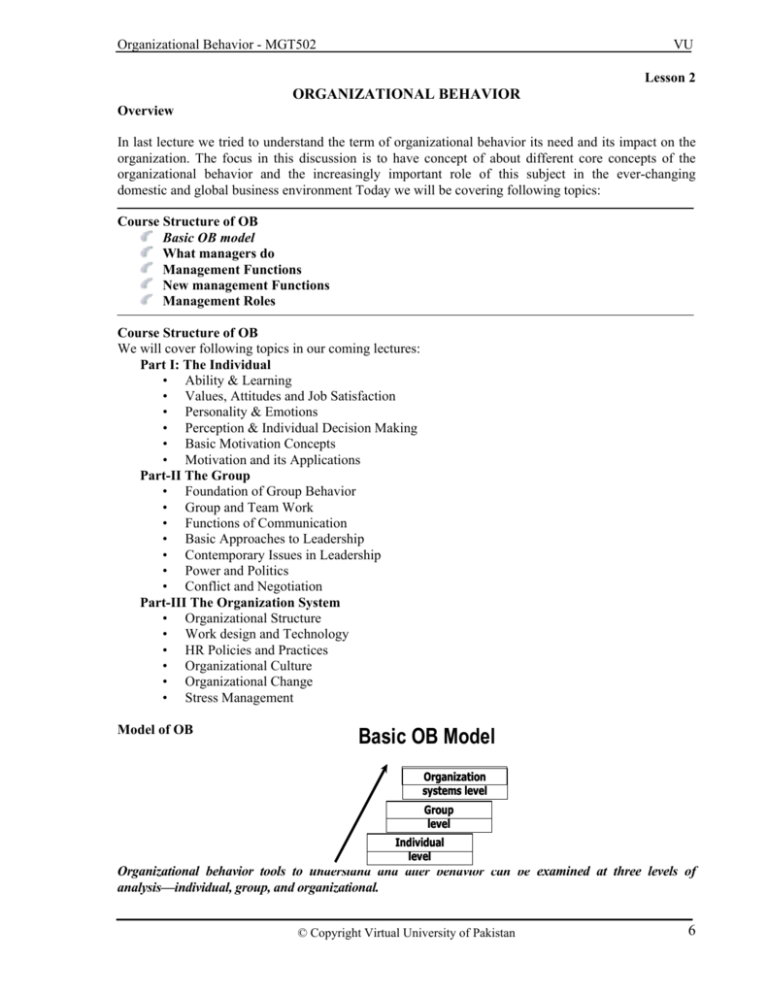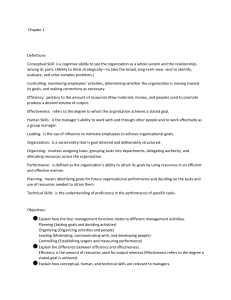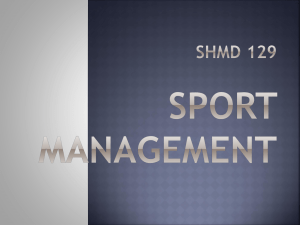Basic OB Model - Learning Management System
advertisement

Organizational Behavior - MGT502 VU Lesson 2 ORGANIZATIONAL BEHAVIOR Overview In last lecture we tried to understand the term of organizational behavior its need and its impact on the organization. The focus in this discussion is to have concept of about different core concepts of the organizational behavior and the increasingly important role of this subject in the ever-changing domestic and global business environment Today we will be covering following topics: Course Structure of OB Basic OB model What managers do Management Functions New management Functions Management Roles Course Structure of OB We will cover following topics in our coming lectures: Part I: The Individual • Ability & Learning • Values, Attitudes and Job Satisfaction • Personality & Emotions • Perception & Individual Decision Making • Basic Motivation Concepts • Motivation and its Applications Part-II The Group • Foundation of Group Behavior • Group and Team Work • Functions of Communication • Basic Approaches to Leadership • Contemporary Issues in Leadership • Power and Politics • Conflict and Negotiation Part-III The Organization System • Organizational Structure • Work design and Technology • HR Policies and Practices • Organizational Culture • Organizational Change • Stress Management Model of OB Basic OB Model Organization systems level Group level Individual level Organizational behavior tools to understand and alter behavior can be examined at three levels of analysis—individual, group, and organizational. © Copyright Virtual University of Pakistan 6 Organizational Behavior - MGT502 VU These factors include personality and ability, attitudes and values, perception and attribution, learning, motivation, stress, and work/life linkages. Individual differences can be divided into personality and ability differences. Understanding the nature, determinants, and consequences of individual differences is essential for managing organizational behavior. An appreciation of the nature of individual differences is necessary to understand why people behave in certain ways in an organization. Group: group is defined as a collection of two or more people who interact together to achieve their goals. A team is a group in which members work together intensively to achieve a common goal. Work groups are the basic building blocks of an organization. Work groups use roles, rules, and norms to control their members’ behavior, and they use several socialization tactics to turn newcomers into effective group members. Groups contribute to organizational effectiveness when group goals are aligned with organizational goals. Organizatio:. Organizational structure and culture affect performance and how the changing global environment, technology, and ethics impact work attitudes and behavior. Organizational structure and culture affect how people and groups behave in an organization. Together they provide a framework that shapes attitudes, behaviors, and performance. Organizations need to create a structure and culture that allow them to manage individuals and inter-group relations effectively. What Managers Do? An understanding of organizational behavior is important to managers, who have the responsibility of improving organizational effectiveness, the ability of an organization to achieve goals. A goal is a desired future outcome that an organization seeks to achieve. A manager supervises one or more subordinates. Managers include CEOs, who head top-management teams of high-ranking executives responsible for planning strategy to achieve top-level managers might be responsible for thousands of workers. But managers are also found throughout the lower levels of organizations and often are in charge of just a few subordinates. All managers face the challenge of helping the organization achieve its goals. Knowledge of organizational behavior increases effectiveness by providing managers with a set of tools. Managers can raise a worker’s self-esteem and increase worker productivity by changing the reward system or the job design. Top-level managers might be responsible for thousands of workers. But managers are also found throughout the lower levels of organizations and often are in charge of just a few subordinates. All managers face the challenge of helping the organization achieve its goals. Knowledge of organizational behavior increases effectiveness by providing managers with a set of tools. Managers can raise a worker’s self-esteem and increase worker productivity by changing the reward system or the job design. Management Functions Management is the process of planning, organizing, leading, and controlling an organization’s human, financial, and material resources to increase its effectiveness. In planning, managers establish their organization’s strategy, in other words, how best to allocate and use resources to achieve organizational goals. Much uncertainty and risk surround the decisions of managers during planning, and an understanding of organizational behavior can improve the quality of decision making, increase success, and lower risk. In organizing, managers establish a structure of relationships that dictate how members of an organization work together to achieve organizational goals. Organizing involves grouping workers into departments, groups, and teams based on the tasks they perform. Organizational behavior offers guidelines on how to organize employees to make the best use of their capabilities and enhance communication and coordination. © Copyright Virtual University of Pakistan 7 Organizational Behavior - MGT502 VU When leading, managers encourage workers to do a good job and coordinate individual and groups so that all organizational members are working toward organizational goals. The study of different leadership methods and how to match leadership styles to the characteristics of the organization is a major concern of organizational behavior. When controlling, managers monitor and evaluate individual, group, and organizational performance to see whether organizational goals are being achieved. Knowledge of organizational behavior allows managers to understand and accurately diagnose work situations and pinpoint the need for corrective action or strive to maintain and improve performance. Several processes at the individual or group levels (e.g., personality conflicts, poor job design) may cause poor performance. Managers perform their four functions by assuming a number of roles in organizations. A role is a set of behaviors or tasks a person is expected to perform because of the position she or he holds in a group or organization. New Management Functions New Managerial Functions To provide leadership and direction Total Quality Continuous Management Improvement Organizational efficiency is increased by reducing the amount of resources, such as people or raw materials, needed to produce a quantity of goods or services. Organizations try to find better ways to utilize and increase the skills and abilities of their workforce. Cross training workers to perform different tasks and finding new ways of organizing workers to use their skills more efficiently improve efficiency. The global competitive challenge facing organizations is to invest in the skills of the workers because better-trained workers make better use of technology. Global pressures have forced organizations to find new ways to increase efficiency. Increased competition has also put pressure on companies to increase the quality of the goods and services they provide. One approach to increasing quality is called Total Quality Management (TQM), a technique borrowed from the Japanese. TQM involves a whole new philosophy of managing behavior in organizations and includes elements like giving workers the responsibility for finding ways to do their jobs more efficiently and ways to improve quality. © Copyright Virtual University of Pakistan 8 Organizational Behavior - MGT502 Companies have historically shown the most innovation, defined “as the process of bringing any new problem-solving ideas into use.” Ideas for reorganizing, cutting costs, putting in new budgeting systems, improving communications, or assembling products in teams are also innovations. Understanding how to manage innovation and creativity is challenging to managers face because creative people are difficult to manage. To encourage innovation, the manager must allow workers freedom (e.g., the use of independent teams) and foster a culture that rewards risk taking. Although all organizations compete for customers, service organizations in particular need to be responsive to customer needs. Because the economy is becoming more and more service based, this is an increasingly important issue. VU The 4-P Cycle of Continuous Improvement People (Skilled, motivated people who can handle change. Less stress.) Productivity Products (Less wasteful, more efficient use of all resources.) (Satisfied customers because of better quality goods/services.) Processes (Faster, more flexible, leaner, and ethical organizational processes. Organizational learning.) Management Roles Managers can use their understanding of organizational behavior to improve their management skills. A skill is an ability to act in a way that allows a person to perform highly in her or his role. Managers need three types of skills: conceptual skills to analyze and diagnose a situation to distinguish between cause and effect; human skills to understand, work with, lead, and control the behavior of individuals and groups; and technical skills, job-specific knowledge and techniques required to perform an organizational role. Effective managers need all three types of skills—conceptual, human, and technical. For example, entrepreneurs often are technically skilled but lack conceptual and human skills. Scientists who become managers have technical expertise, but low levels of human skills. The ten roles can be grouped as being primarily concerned with interpersonal relationships, the transfer of information, and decision making. 1. Interpersonal roles • • • Figurehead—duties that are ceremonial and symbolic in nature Leadership—hire, train, motivate, and discipline employees Liaison—contact outsiders who provide the manager with information. These may be individuals or groups inside or outside the organization. 2. Informational Roles • • • Monitor—collect information from organizations and institutions outside their own Disseminator—a conduit to transmit information to organizational members Spokesperson—represent the organization to outsiders 3. Decisional Roles • • • • Entrepreneur—managers initiate and oversee new projects that will improve their organization’s performance Disturbance handlers—take corrective action in response to unforeseen problems Resource allocators—responsible for allocating human, physical, and monetary resources Negotiator role—discuss issues and bargain with other units to gain advantages for their own unit © Copyright Virtual University of Pakistan 9 Organizational Behavior - MGT502 VU Management Skills Robert Katz has identified three essential management skills: technical, human, and conceptual. 1. Technical Skills • The ability to apply specialized knowledge or expertise. All jobs require some specialized expertise, and many people develop their technical skills on the job. 2. Human Skills • The ability to work with, understand, and motivate other people, both individually and in groups, describes human skills. Many people are technically proficient but interpersonally incompetent 3. Conceptual Skills 1. The mental ability to analyze and diagnose complex situations 2. Decision making, for example, requires managers to spot problems, identify alternatives that can correct them, evaluate those alternatives, and select the best one. Skills Exhibited by an Effective Manager 1. Clarifies goals and objectives for everyone involved 2. Encourages participation, upward communication, and suggestions 3. Plans and organizes for an orderly work flow 4. Has technical and administrative expertise to answer organization-related questions 5. Facilitates work through team building, training, coaching and support 6. Provides feedback honestly and constructively 7. Keeps things moving by relying on schedules, deadlines, and helpful reminders 8. Controls details without being over-bearing 9. Applies reasonable pressure for goal accomplishment 10. Empowers and delegates key duties to others while maintaining goal clarity and commitment 11. Recognizes good performance with rewards and positive reinforcement Evolution of the 21st-Century Manager Past Managers Today’s Managers • Primary Role Order giver, privileged elite, manipulator, controller Facilitator, team member, teacher, advocate, sponsor • Learning & Knowledge Periodic learning, narrow specialist Continuous life-long learning, generalist with multiple specialties • Compensation Criteria Time, effort, rank Skills, results • Cultural Orientation Monocultural, monolingual Multicultural, multilingual © Copyright Virtual University of Pakistan 10






